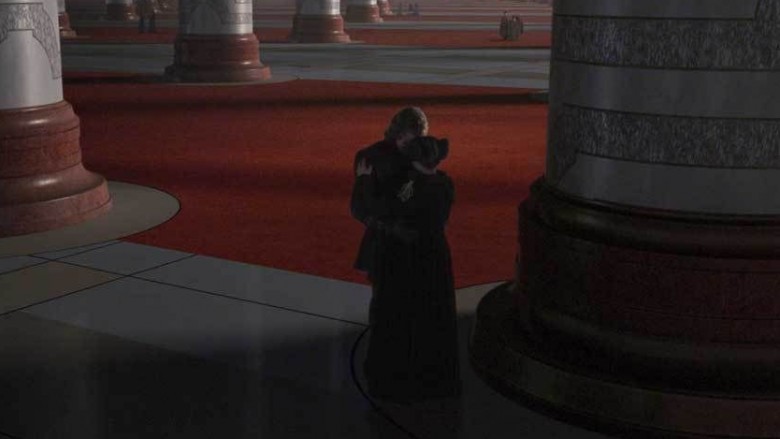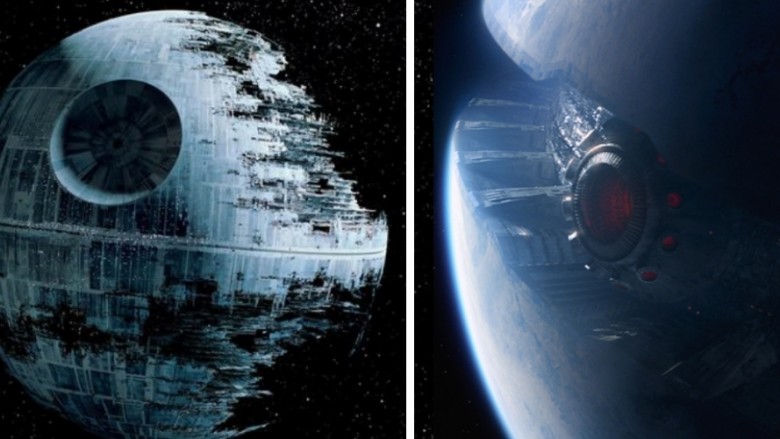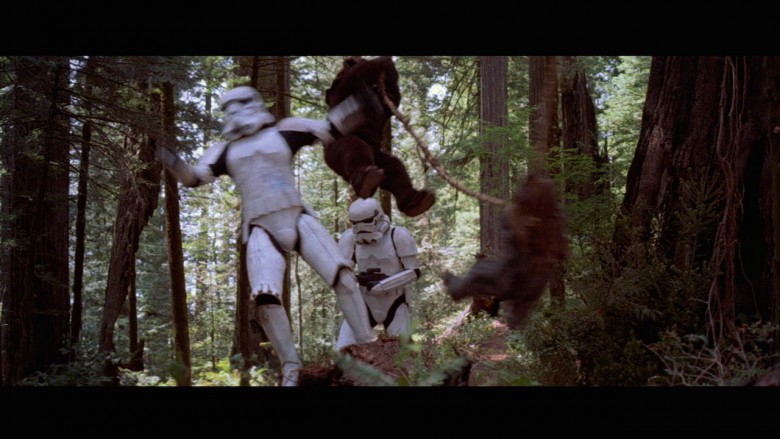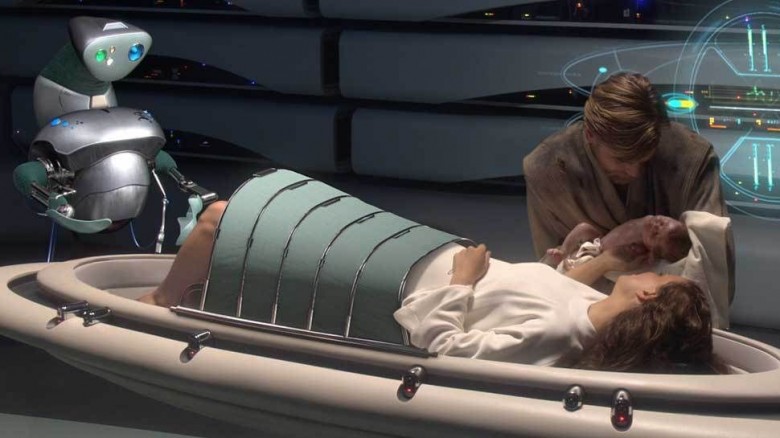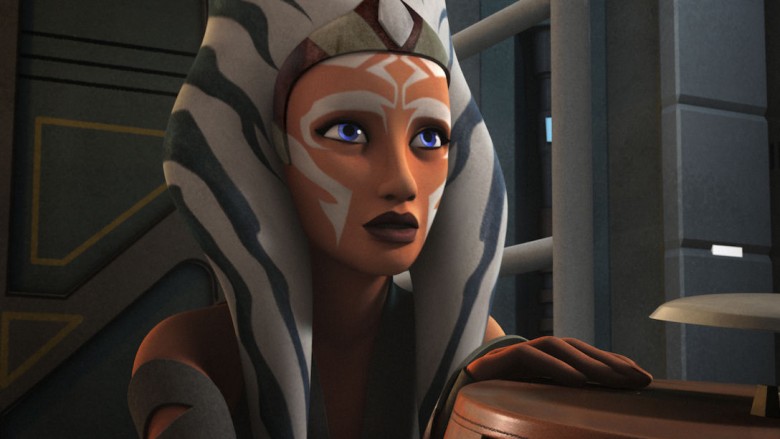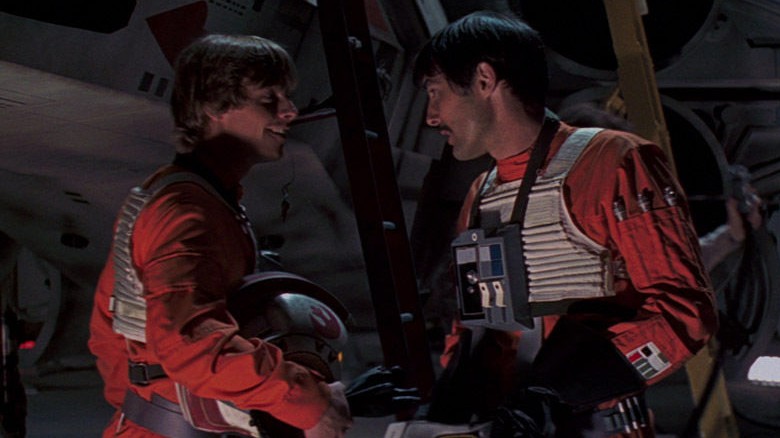Things Most People Don't Admit They Like About Star Wars
When it comes to Star Wars, there's very little about the franchise not to like. Even still, it may be even better than you think. Yes, some of the saga's flaws are certainly hard to overlook (hi, Jar-Jar!), but others weren't quite as bad as we make them out to be:
Anakin and Padme's awkward love is kind of sweet
The Phantom Menace began one of the galaxy's most uncomfortable (and apparently, only) romances. Preteen pod-racing dynamo Anakin "don't call me Ani" Skywalker helped teen Queen Padme Amidala re-ascend to the stars after her ridiculously shiny silver ship broke down on galactic bright spot Tatooine. During their time together, the ruler of Naboo—who isn't old enough to get a driver's license on Earth, but is trusted to run an entire planet—and the sand-hating wunderkind grew fond of each other, much like a babysitter and her ingratiating ward.
Ten years later, during Attack of the Clones, their May-July romance "blossoms" after they run away from their problems, disobey a very specific Jedi mandate about hooking up, and whittle through a forests' worth of George Lucas' wooden dialogue. The film closed with their illicit marriage, hand in robot hand, setting up the Force prodigy's inevitable fall in Revenge of the Sith. The trilogy-ender somewhat glossed over their relationship, turning Padme into more of a plot contrivance that drove her husband's turn from whiny Jedi into James Earl Jones (eventually).
The weird thing was, despite their wooden relationship (and Padme's footnote role in Episode III), their relationship somehow wound up surprisingly sweet. Perhaps it was our suspension of disbelief—or perhaps, only at the end, did Natalie Portman finally get to show off a modicum of her acting skill—but the decaying relationship of the Galactic Republic's power couple actually gives their characters more depth, salvaging much of what came before. Their downward spiral is actually somewhat heart-wrenching. Of course, the true irony is that Anakin's fall from grace, and almost killing the woman he flipped the evil switch for, actually gave the final act some depth.
The Force Awakens is a major homage to A New Hope
The Force Awakens was the event of 2015, as the first Star Wars movie in over 10 fanboy-tears stained years. The only problem was that many of us experienced strong feelings of déjà vu while watching J.J. Abrams' tour de Force: a desert planet, a mystically endowed orphan, a plucky band of freedom fighters, a masked menace, a giant planet-killing machine ... you get the picture. At the same time, many of us forgive you for the redux, Lucasfilm.
Force Awakens may have walked in a lot of the same footprints of A New Hope, but the film sort of needed to revisit past formulas, to catch on to the rhythm of the franchise. More than anything else, Abrams' strategy worked. Sure, there were a few plot holes and flaws in the seventh movie, but that's a Star Wars tradition too. TFA still packed enough original material into the homage to excite minor fans and neophytes, baiting the hook for the cosmic franchise's future. In the long run, Star Wars is all about space operatics, laser samurai sword fights, and bringing new hope to a fresh generation. The original trilogy was also heavily influenced by classical movies, serials, and literary tropes, so a little pastiche is nothing new for Star Wars.
Not to mention that, for the thousands of cranky forty-somethings bemoaning the "soft reboot" on comment threads and message boards across the web, there are millions of younglings just discovering the wonders of the far-away galaxy. That, in and of itself, is magical.
'Noooooo!' actually makes sense under the circumstances
Imagine that you just had an impromptu hand removal via red-hot sword and are clinging to a beam above a deadly drop. Then, you find out (cave-dweller spoiler alert) the vilest villain in the galaxy is your dad. "Nooooooooo!!!!" sounds like a pretty valid response.
Alright, what about this: Imagine you've had a rough day, filled with slaughtering young kids, killing separatist leaders, strangling your wife, and fighting your best friend to the almost-death. On top of all that, you find yourself in the midst of being fitted for a clunky, prosthetic suit—one which is your only means of survival—when the boss man breaks the news that you just accidentally killed your wife. Sure, everyone responds to such an unpleasant situations differently, but "noooooooooo!!!!" fits the bill pretty well.
Both Luke Skywalker and Darth Vader's hammy reactions to learning horrible truths seem pretty easy to make fun of. Audiences everywhere mocked the Skywalker habit of letting out their anguish in drawn-out nooooooo's, and it's our right, as hardened viewers of countless dramatic sequences strewn throughout film and television. Even though father and son's distressed cries seem cheesy, once you imagine yourself in their position, letting out a guttural (if whiny) scream makes a lot of sense.
Still not feeling it? Just imagine that Disney announced the digital addition of Jar Jar to every single movie. We think that should just about do it. Of course, the goofy add-on "noooooooo" to the climax of Return of the Jedi is on its own.
The Ewoks *sigh* save the day
Walking into a heavily guarded outpost to disable a force field which is protecting a half-constructed, moon-sized, killer space station is already challenging enough. Before even getting there, navigating through a dense forest moon adds its own troubles into the mix. Then, to top it all off, you get captured by a bunch of shrunken, pre-industrial Wookiees. Fortunately, they're friendly.
When George Lucas imbued his kid-friendly Ewoks with the power to overthrow a technologically superior army in Return of the Jedi—Stormtroopers' inability to hit the broadside of a Hutt notwithstanding—he stretched some audience members' suspension of disbelief. However, the guerrilla resistance of these pup-faced critters had a genuine basis in reality. Lucas revealed on the director's commentary for Jedi that these plucky little forest-dwellers were inspired by the Viet Cong. Much like the North Vietnamese forces, the Ewoks were out-teched, outnumbered, and outgunned, but used their proficiency in their home terrain to wreak havoc on the Empire's forces.
Sure, the chipper little fuzzballs may grate on some peoples' nerves, but even the biggest hater has to admit there's something inspiring about those plucky Imperial foils as they turn the tide during the climactic third act. Watching them descend from the canopy like furry green berets, and crush Imperial walkers with basic traps, really gets the blood pumping. If you're still skeptical that bolos and arrows can wipe out a platoon of the Emperors finest troops, don't forget the power of a well-motivated underdog with a lot at stake. "Yub nub," indeed.
Padme Amidala's death by broken heart is understandable
The total lack of Padme in the classic Star Wars trilogy, in addition to Leia's confession about her mother dying "when I was very young," foreshadowed a bad end for Anakin's baby mama. After the conclusion to the Prequels, though, many fans bemoaned Lucas' killing blow to Padme—which implied that the senator from Naboo died of a broken heart—as corny. Some fans have even vehemently argued that her unusual end is the result of Dark Side manipulation, or other unstated means.
The story itself is vague, as the medical droids only note that Padme had "lost the will to live." Of course, given the circumstances, it's hard to blame her. Anakin, the love of her life—whom she risked career and Jedi scorn for—just accused her of betrayal, and then choked her out through the Force. As if that weren't enough, her good friend Obi-Wan engaged the Dark Side adept in a duel to the death, cutting down the father of her unborn children. Even though she technically doesn't witness this, she is carrying two very Force-sensitive babies. She felt it.
Considering "death by despair" is a common literary trope, and the traumatic sequence of events Padme just endured, coupled with the sudden, enforced labor to save her unborn children, her reaction is certainly understandable. The tragedy she goes through ought to hit even the most stalwart anti-Prequel-ite in the feels, whether or not they'd willingly admit it.
Side note: the American Heart Association does recognize broken heart syndrome, although it's not life-threatening.
R2-D2's conveniently ended droid coma
Some far-away galaxy fanatics felt something was missing from The Force Awakens: R2-D2. Although his flap-jawed, golden cohort makes his now red-armed presence very known in Episode VII, the plucky little fireplug is conspicuously absent throughout the proceedings. A little Force flashback and moment of exposition is all we get from the series' essential droid ... until the very last moment.
It sure is convenient that Artoo wakes up just in time to swap maps with BB-8. The astromech ends his "low-power mode" exactly when he's needed to connect the dots for the Resistance, which totally doesn't feel like a MacGuffin at all. Thing is, if you want to know the reason, you have to read. The official novelization of Episode VII explores the reason behind the droid's sudden awakening (and impressive knowledge of star systems). After receiving a "verbal" prompt from BB-8, R2-D2 whips out a copy of the Empire's extensive galactic maps — including those of Jedi Temples — he picked up while making nice with the Death Star's central computer. Well, it sounds good on paper, in any case.
In all honesty, Artoo really is the unsung hero of the Star Wars saga. Throughout the course of the films, he shuts down the garbage compactor, fixes the X-Wing's stabilizer, puts out a nasty fire on the Millennium Falcon, and even takes on a day laborer gig with Jabba to set up Luke's dramatic sail barge rescue. That's just in the Original Trilogy! Admittedly, his ability to override complex and well-protected computer systems is questionable, and his suddenly manifested power of flight in Attack of the Clones came out of left field. But despite everything, even the most die-hard skeptic probably got a little misty when R2-D2 sprung to life, delivering Luke's coordinates, and once again saving the day.
Plot device or not, Star Wars just isn't the same without the little guy.
Ahsoka
Like them or not, the Prequel Trilogy still brought in a ridiculous amount of money for LucasFilm. Although Lucas himself seemed over making Star Wars films in their wake, he certainly left the door open for more entries, including the pilot-like Clone Wars movie and its follow-up TV series. Although slow on the uptake, the animated series quickly became a haven for franchise lore, retrofitting the somewhat awkward first three films with deeper meaning, as well as expanding our understanding of both major and minor characters.
One of the liberties showrunner Dave Filoni took with Clone Wars, was creating a heretofore-unmentioned apprentice for Anakin, the Togruta padawan, Ahsoka Tano. Initially hated by fans for being a canon-hiccup, as well as somewhat—okay, thoroughly—irritating, "Snips" quickly transitioned into a complex character and powerful Force user in her own right. Her departure from the Jedi Order during the final season, as well as her subsequent reappearance as an adult, "gray Jedi" in Star Wars: Rebels gave Ahsoka a rich, fascinating story arc (and probably gave birth to way too many creepy slash-fictions).
After such a phenomenal journey—credit due to Filoni and voice actor Ashley Ekstein—all but a stubbornly loyal contingent adores, or at least begrudgingly accepts, the character. Despite her dubious beginnings, her wicked skills, and status as a Rebel hero, merely cemented her place in the beloved character panoply.
The prequels' CGI was pretty impressive for the time
Star Wars fans often dump on the Prequels for being heavily laden with special effects—not taking into account that Episodes I-III actually contained more practical effects than the OG trilogy. It's really that George Lucas chose to enhance or create entire worlds and characters (and yes, Jar Jar) digitally, giving the film its so-called "slick" look—an intentional choice by Lucas to differentiate the first three films from the grittier feel of the the OT.
In the long run, the computer-generated effects in the Prequels, if somewhat dated, are still pretty impressive, considering the lackluster CG that came before them (Anaconda, anyone?). The overall universe still looks pretty decent for the most part, and the advanced technology allowed Lucas to create some memorable and unique new planets. With the state-of-the-art technology, ILM was able to depict an undersea kingdom, an oceanic city (sadly populated by Gungans), the city-wide planet of Coruscant, as well as rocky Geonosis and fiery Mustafar, escaping the confines of traditional terrestrial cinematography. Oh sure, you could film the entire climactic duel between Obi-Wan and Anakin in and around an active volcano, but just try slipping that one past OSHA and the Screen Actors Guild.
Pod racing was pretty exciting
Once a cause célèbre for Star Wars fans around the world, The Phantom Menace rapidly turned into a wildly divisive entry in the saga, for a number of reasons. In addition to George Lucas' drastic deviation from several well-established elements from the classic lore—they are his creations after all (*grumble*)—many old timers can't forgive Lucas for turning Obi-Wan's cohort Anakin, once the "best star-pilot in the galaxy," into an untested pod racing prodigy.
While some of us were busy being distracted by mythological inconsistencies in the franchise, we failed to notice how enjoyable the actual pod racing sequence actually was. Certainly, Lucas could have chopped the race-time in half and nobody would have noticed. Thanks to state-of-the-art digital effects, though, and some great cameos—c'mon, Tusken Raiders' taking potshots at the racers was awesome—the Boonta Eve Classic offered up a welcome distraction from all the talk of immaculate conceptions and midichlorians, the Jedi gambling (with "human" lives, no less), and the thrilling parliamentary procedures of the Galactic Senate.
Viable concerns as to why the Jedi Knights didn't liberate the slave populace of Tatooine aside, the pod race was still shorter, more fun, and more crash-laden than the average six-billion-lap NASCAR event.
Some parts of the Special Edition weren't total sacrilege
One thing many old school fans can agree on is that George Lucas tampered with a lot of memories when he tweaked the Original Trilogy into the much-maligned Special Edition—including the lamentable "Greedo shot first" debacle. Some of his "fixes" really didn't resonate with fans, such as the plot-irrelevant Jabba scene in Mos Eisley, the "Jedi Rocks" musical swap out in Return of the Jedi (and we thought "Lapti Nek" was embarrassing), and the Force-ghost Sebastian Shaw-Hayden Christensen exchange. Others were merely nitpicky, like adding a bonus batch of X-Wings in A New Hope, turning Han's confrontation from a gaggle of Stormtroopers into a standoff with a friggin' legion, or the extra-phallic Sarlaac.
On the other hand, some of Lucas' changes actually made sense. Those of us still clutching onto their lovingly worn copies of pre-SE video tapes remember the many minor visual flaws better than others, including the weird glitches on snow speeders and X-Wing cockpits due to green-screening, the rotoscoped boxes around asteroids during the intense chase in Empire, the shoddy matte paintings in Dagobah, and the startlingly light-on-windows Cloud City (especially for a place with supposedly the best sunsets around). The Special Edition finally gave us the best views from Bespin, actually built up suspense for Luke's showdown with the Rancor, and blended some of the mildly off-putting glitches out of the film. Hell, the celebrations from around the galaxy—preemptive though they might be, given the galaxy's status in Force Awakens—were pretty damn cool.
Don't get us wrong — there are still plenty of reasons to grumble about the Special Editions, but at least they gave us Biggs back.
